Study on the Springback Effect and Surface Property for Ultrasonic-Assisted Incremental Sheet Forming of Aluminum Alloy
Abstract
:1. Introduction
2. Experimental Methods
2.1. Experimental Setup
2.2. Measurement of Springback and Surface Property
2.2.1. Springback Effect
2.2.2. Surface Residual Stress
2.2.3. Measurement of Surface Topography
2.2.4. Measurement of Surface Hardness
3. Results and Discussions
3.1. Springback Effect
3.2. Surface Residual Stress
3.3. Measurement of Surface Topography
3.4. Measurement of Surface Hardness
4. Conclusions
- (1)
- The application of ultrasonic vibration can reduce the springback effect.
- (2)
- The waviness feature of the contact surface becomes gradually weaker and surface roughness decreases with the continuous increase of ultrasonic amplitude due to the high-frequency impact of the forming tool applied ultrasonic vibration.
- (3)
- The application of ultrasonic vibration can reduce the surface hardness and promote the surface residual stress distribution to be more uniform to a certain extent.
Author Contributions
Funding
Data Availability Statement
Acknowledgments
Conflicts of Interest
References
- Kumar, A.; Gulati, V. Experimental investigation and optimization of surface roughness in negative incremental forming. Measurement 2019, 131, 419–430. [Google Scholar] [CrossRef]
- Jackson, K.P.; Allwood, J.M.; Landert, M. Incremental forming of sandwich panels. J. Mater. Process. Technol. 2007, 204, 290–303. [Google Scholar] [CrossRef]
- Malhotra, R.; Xue, L.; Belytschko, T.; Cao, J. Mechanics of fracture in single point incremental forming. J. Mater. Process. Technol. 2012, 212, 1573–1590. [Google Scholar] [CrossRef]
- Li, Y.L.; Zhai, W.D.; Wang, Z.J.; Li, X.Q.; Sun, L.L.; Li, J.F.; Zhao, G.Q. Investigation on the material flow and deformation behavior during ultrasonic-assisted incremental forming of straight grooves. J. Mater. Res. Technol. 2020, 9, 433–454. [Google Scholar] [CrossRef]
- Ashida, Y.; Aoyama, H. Press forming using ultrasonic vibration. J. Mater. Process. Technol. 2007, 187–188, 118–122. [Google Scholar] [CrossRef]
- Hung, J.C.; Tsai, Y.C.; Hung, C. Frictional effect of ultrasonic-vibration on upsetting. Ultrasonics 2007, 6, 277–284. [Google Scholar] [CrossRef] [PubMed]
- Siddiq, A.; El Sayed, T. Ultrasonic-assisted manufacturing processes: Variational model and numerical simulations. Ultrasonics 2012, 52, 521–529. [Google Scholar] [CrossRef] [PubMed]
- Siu, K.W.; Ngan, A.H.W.; Jones, I.P. New insight on acoustoplasticity Ultrasonic irradiation enhances subgrain formation during deformation. Int. J. Plast. 2011, 27, 788–800. [Google Scholar] [CrossRef]
- Dutta, R.K.; Petrov, R.H.; Delhez, R.; Hermans, M.J.M.; Richardson, I.M.; Böttger, A.J. The effect of tensile deformation by in situ ultrasonic treatment on the microstructure of low-carbon steel. Acta Mater. 2013, 61, 1592–1602. [Google Scholar] [CrossRef]
- Yao, Z.H.; Kim, G.Y.; Wang, Z.H.; Faidley, L.; Zou, Q.Z.; Mei, D.Q.; Chen, Z.C. Acoustic softening and residual hardening in aluminum: Modeling and experiments. Int. J. Plast. 2012, 39, 75–87. [Google Scholar] [CrossRef]
- Edward, L. Apparatus and Process for Incremental Dieless Forming. US38850764A, 19 September 1967. [Google Scholar]
- Kitazawa, K.; Wakabayashi, A.; Murata, K.; Yaejima, K. Metal-flow phenomena in computerized numerically controlled incremental stretch-expanding of aluminum sheets. J. Jpn. Inst. Light Met. 1996, 46, 65–70. [Google Scholar] [CrossRef] [Green Version]
- Duflou, J.R.; Habraken, A.-M.; Cao, J.; Malhotra, R.; Bambach, M.; Adams, D.; Vanhove, H.; Mohammadi, A.; Jeswiet, J. Single point incremental forming: State-of-the-art and prospects. Int. J. Mater. Form. 2018, 11, 743–773. [Google Scholar] [CrossRef]
- Trzepieciński, T.; Kubit, A.; Dzierwa, A.; Krasowski, B.; Jurczak, W. Surface finish analysis in single point incremental sheet forming of rib-stiffened 2024-T3 and 7075-T6 alclad aluminium alloy panels. Materials 2021, 14, 1640. [Google Scholar] [CrossRef] [PubMed]
- Zhai, W.D.; Li, Y.L.; Cheng, Z.N.; Sun, L.L.; Li, F.Y.; Li, J.F. Investigation on the forming force and surface quality during ultrasonic-assisted incremental sheet forming process. Int. J. Adv. Manuf. Technol. 2020, 106, 2703–2719. [Google Scholar] [CrossRef]
- Naghdi Sedeh, M.R.; Ghaei, A. The effects of machining residual stresses on springback in deformation machining bending mode. Int. J. Adv. Manuf. Technol. 2021, 114, 1087–1098. [Google Scholar] [CrossRef]
- Mirnia, M.J.; Dariani, B.M.; Vanhove, H.; Duflou, J.R. Thickness improvement in single point incremental forming deduced by sequential limit analysis. Int. J. Adv. Manuf. Technol. 2014, 70, 2029–2041. [Google Scholar] [CrossRef]
- Kim, T.J.; Yang, D.Y. Improvement of formability for the incremental sheet metal forming process. Int. J. Mech. Sci. 2000, 42, 1271–1286. [Google Scholar] [CrossRef]
- Ingarao, G.; Ambrogio, G.; Gagliardi, F.; Lorenzo, R.D. A sustainability point of view on sheet metal forming operations: Material wasting and energy consumption in incremental forming and stamping processes. J. Clean. Prod. 2012, 29–30, 255–268. [Google Scholar] [CrossRef]
- Zhang, S.; Tang, G.H.; Li, Z.; Jiang, X.K.; Li, K.J. Experimental investigation on the springback of AZ31B Mg alloys in warm incremental sheet forming assisted with oil bath heating. Int. J. Adv. Manuf. Technol. 2020, 109, 535–551. [Google Scholar] [CrossRef]
- Deshpande, A.; Hsu, K. Acoustic energy enabled dynamic recovery in aluminium and its effects on stress evolution and post-deformation microstructure. Mater. Sci. Eng. A 2018, 711, 62–68. [Google Scholar] [CrossRef]
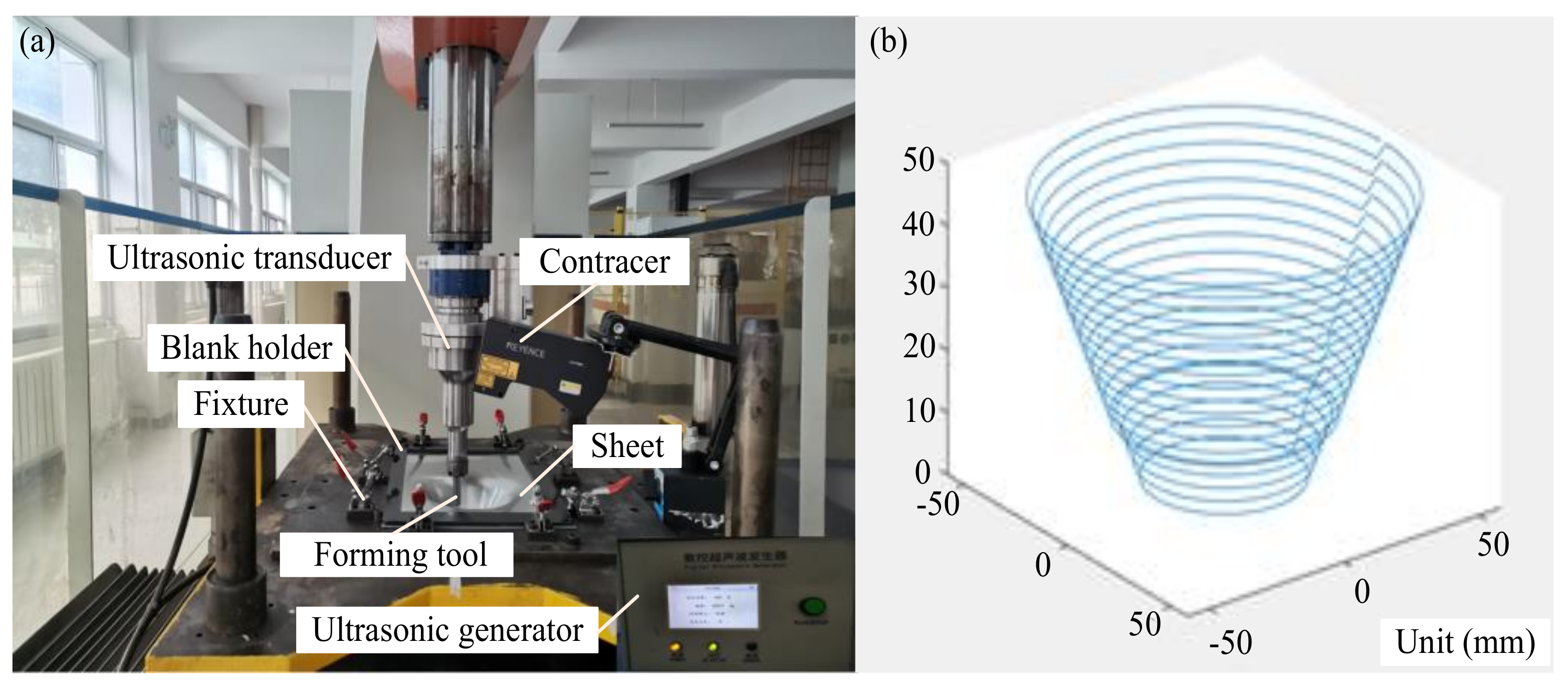
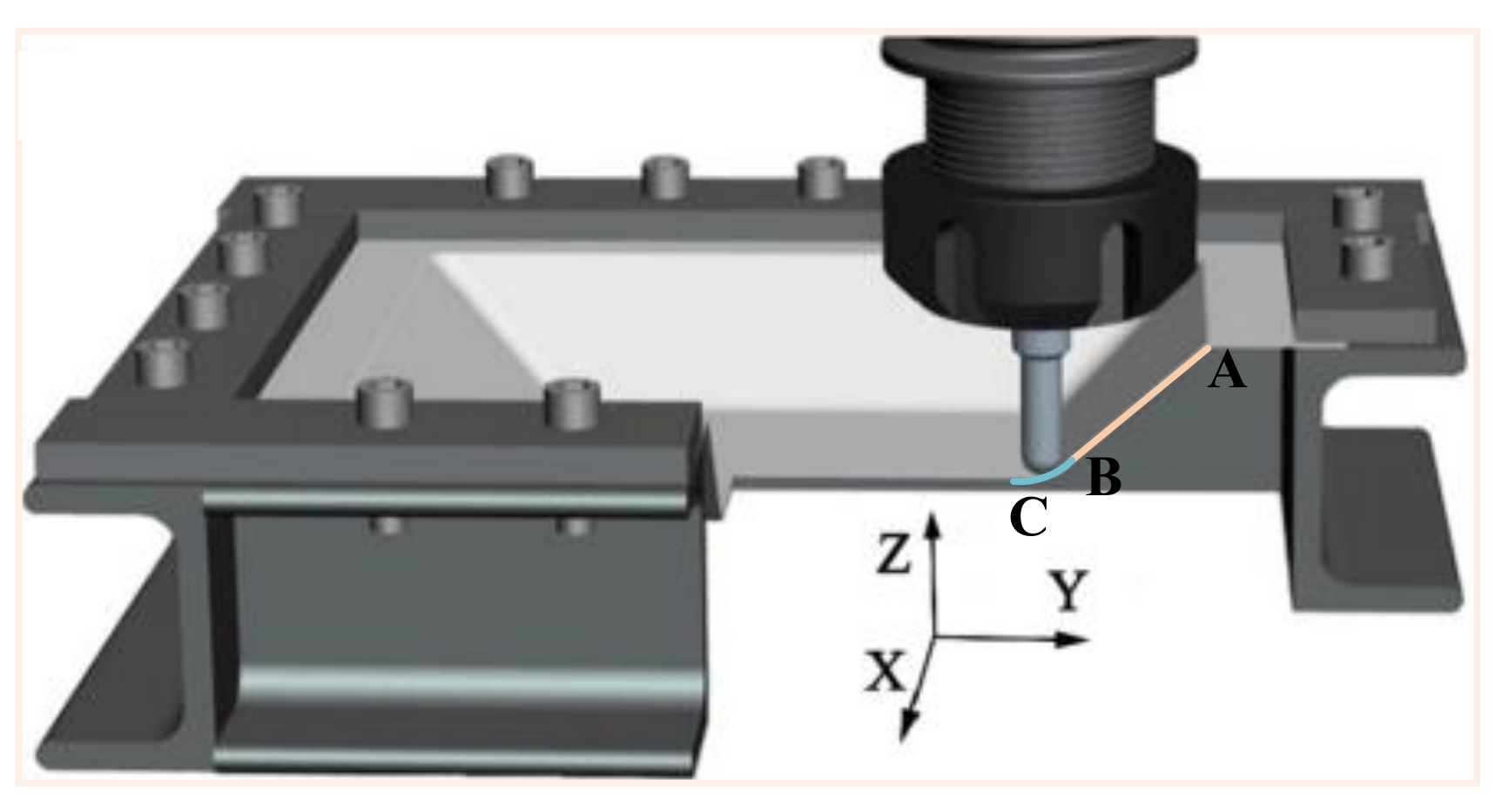
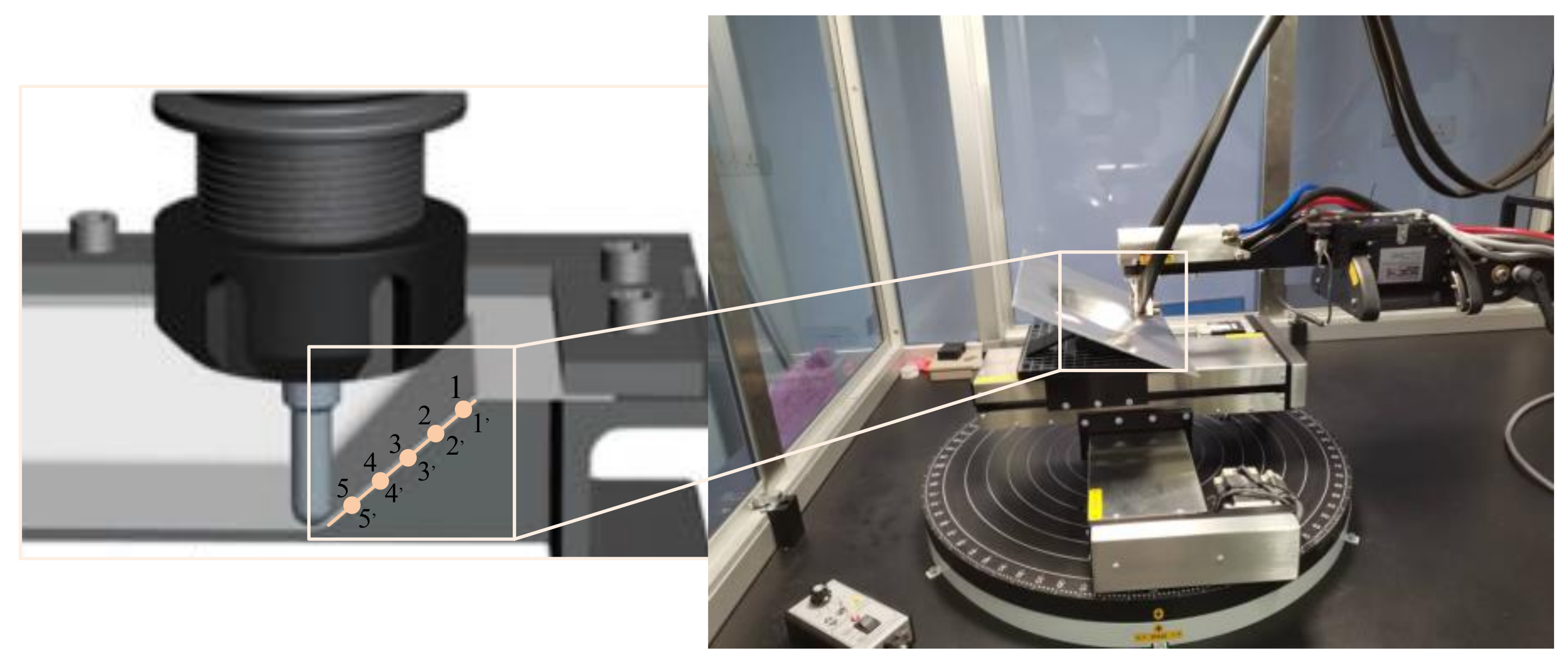

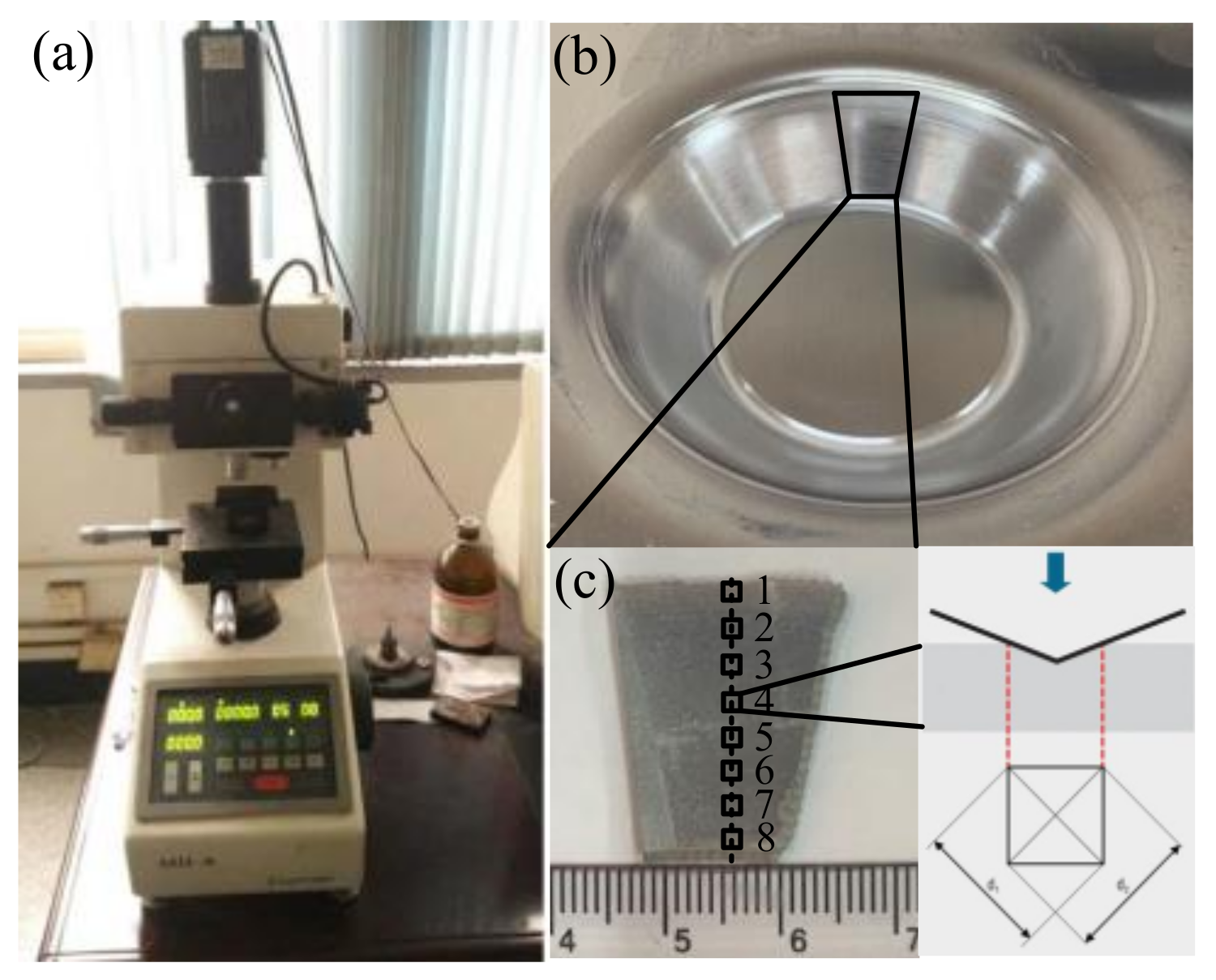
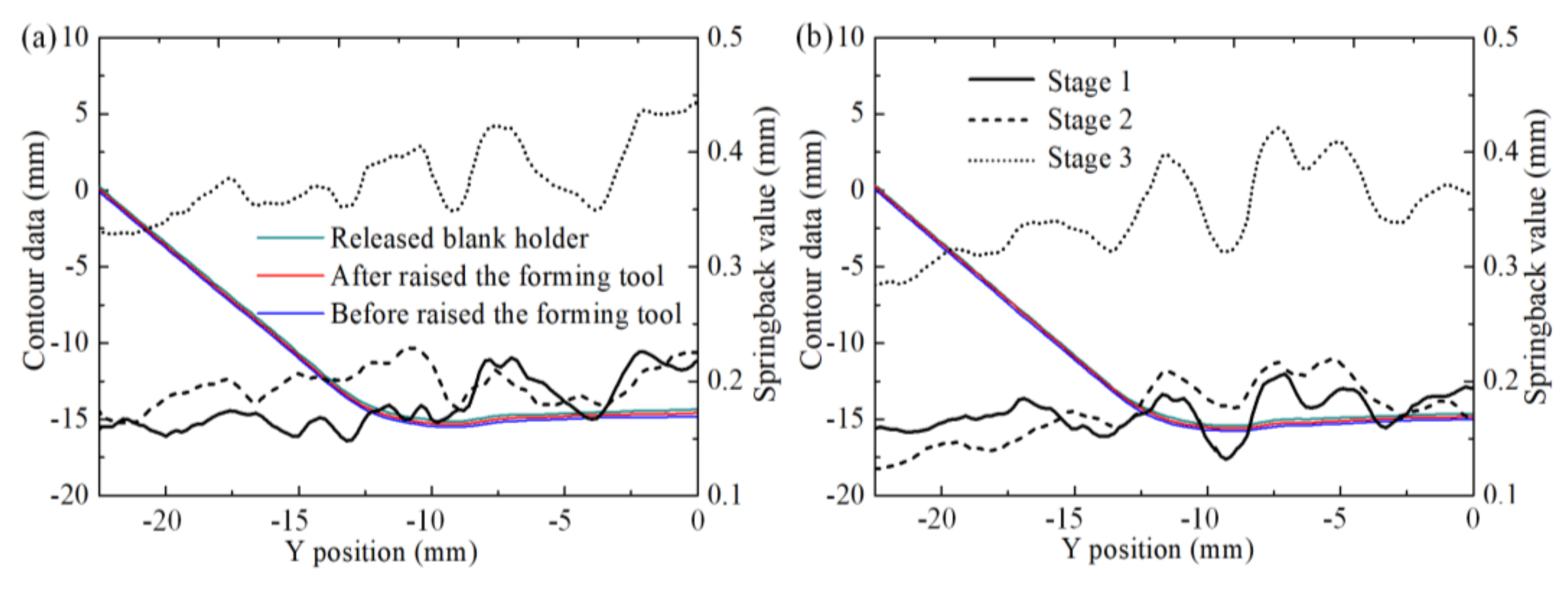
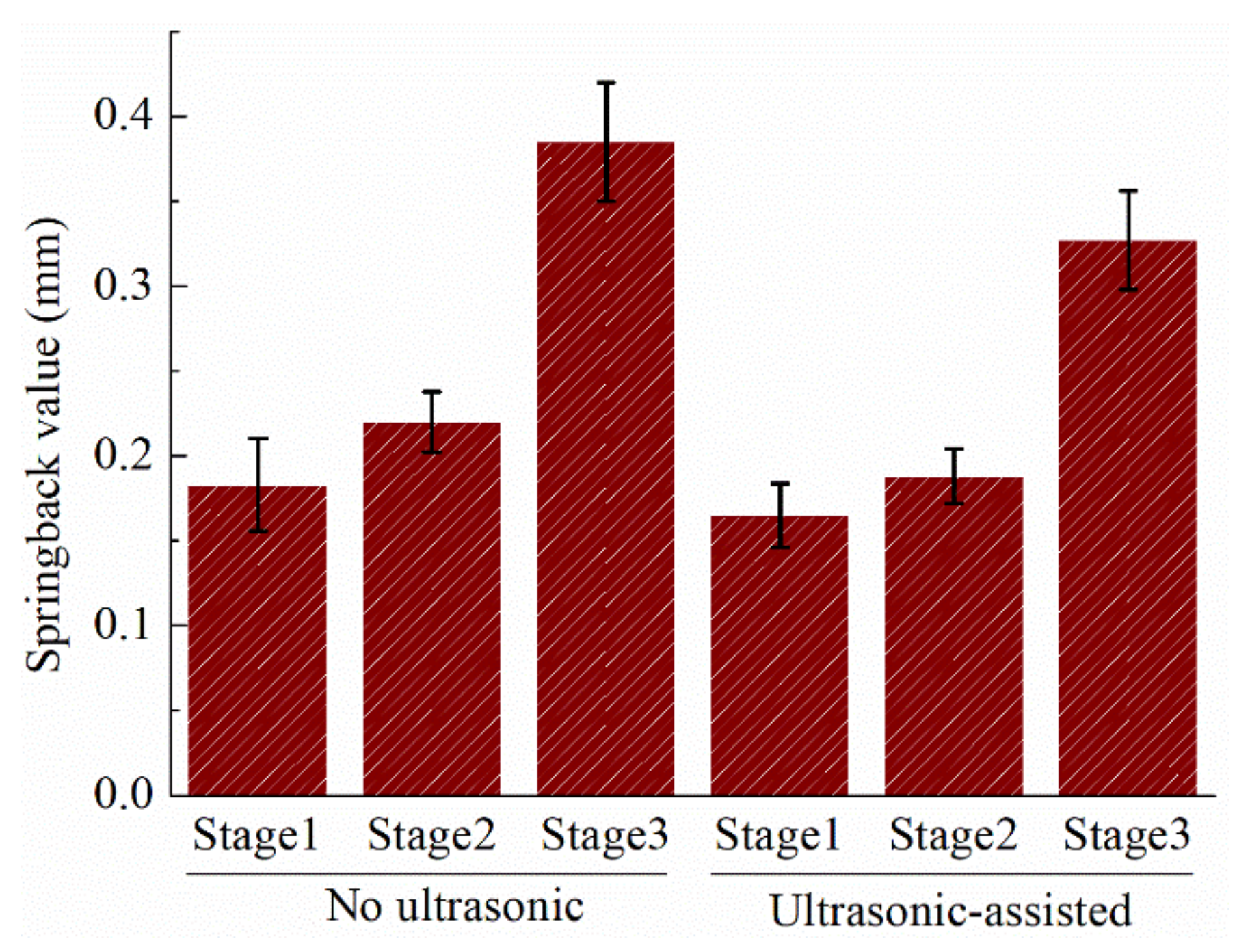
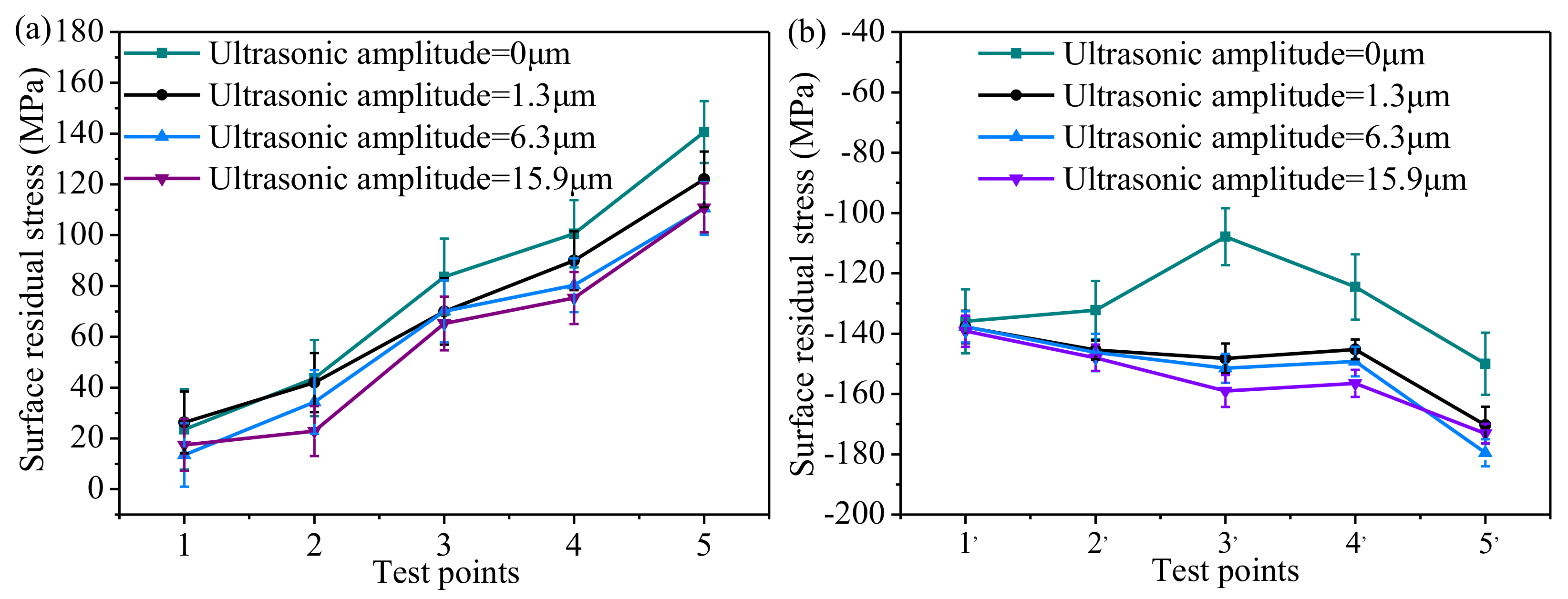
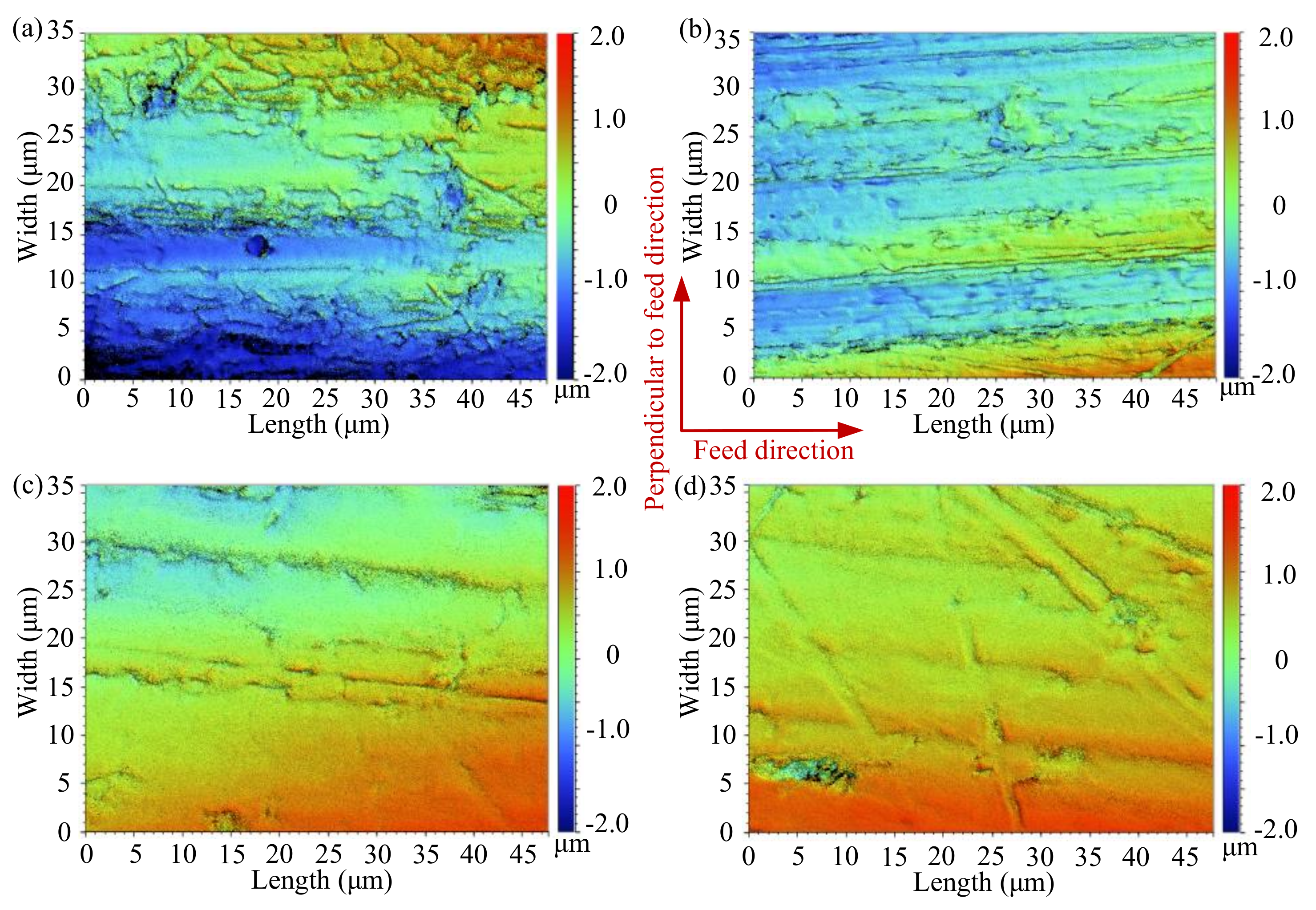
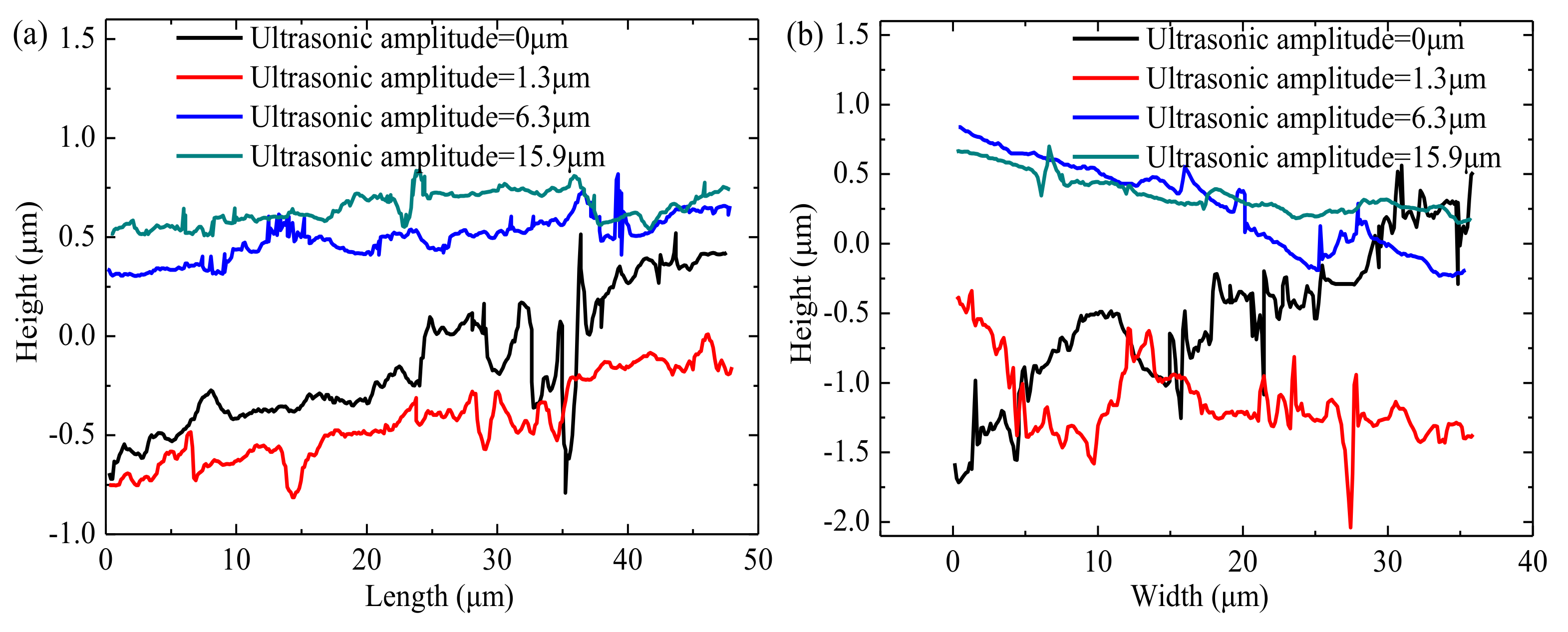

| Material | Mg (wt %) | Si (wt %) | Cu (wt %) | Zn (wt %) | Mn (wt %) | Cr (wt %) | Fe (wt %) | Others | Al (wt %) |
|---|---|---|---|---|---|---|---|---|---|
| AA-5052 | 2.2~2.8 | 0.25 | 0.10 | 0.10 | 0.10 | 0.15~0.35 | 0.40 | 0.15 | Remainder |
| Material | Young’s Modulus (GPa) | Poisson’s Ratio | Yield Stress (MPa) | Ultimate Tensile Strength (MPa) | Maximum Elongation |
|---|---|---|---|---|---|
| AA-5052 | 69.3 | 0.33 | 65 | 244 | 20% |
| Test No. | Tool Diameter (mm) | Layer Feed (mm) | Power (%) | Ultrasonic Amplitude (μm) | Feed Speed (mm/min) |
|---|---|---|---|---|---|
| 1 | 5 | 0.3 | 0 | 0 | 800 |
| 2 | 5 | 0.3 | 40 | 1.3 | 800 |
| 3 | 5 | 0.3 | 70 | 6.3 | 800 |
| 4 | 5 | 0.3 | 99 | 15.9 | 800 |
Publisher’s Note: MDPI stays neutral with regard to jurisdictional claims in published maps and institutional affiliations. |
© 2021 by the authors. Licensee MDPI, Basel, Switzerland. This article is an open access article distributed under the terms and conditions of the Creative Commons Attribution (CC BY) license (https://creativecommons.org/licenses/by/4.0/).
Share and Cite
Sun, Y.; Lu, Z.; Li, C.; Wang, R.; Zhai, W. Study on the Springback Effect and Surface Property for Ultrasonic-Assisted Incremental Sheet Forming of Aluminum Alloy. Symmetry 2021, 13, 1217. https://doi.org/10.3390/sym13071217
Sun Y, Lu Z, Li C, Wang R, Zhai W. Study on the Springback Effect and Surface Property for Ultrasonic-Assisted Incremental Sheet Forming of Aluminum Alloy. Symmetry. 2021; 13(7):1217. https://doi.org/10.3390/sym13071217
Chicago/Turabian StyleSun, Yujing, Zhenyun Lu, Chao Li, Rongtao Wang, and Weidong Zhai. 2021. "Study on the Springback Effect and Surface Property for Ultrasonic-Assisted Incremental Sheet Forming of Aluminum Alloy" Symmetry 13, no. 7: 1217. https://doi.org/10.3390/sym13071217





